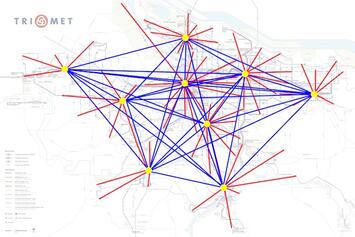
Portland’s TriMet transit agency is attempting to serve a 2020s urban area with a 1910 transit system, says a new report published by the Cascade Policy Institute. The agency’s infatuation with rail transit underscores this problem, as rail transit makes no sense for rapidly evolving regions with multiple economic centers. TriMet’s current route map works well only for downtown employees: while more than 40 percent of downtown workers took transit to work before the pandemic, less than 3.5 percent of workers in the rest of the urban area used transit.
All of these problems were made worse by the pandemic, which hit rail transit especially hard and which greatly reduced the importance of downtown Portland as an economic center. According to the latest report, Portland’s downtown has the second-worst recovery of any of the nation’s 50 largest downtowns, with less than 40 percent the economic activity of the pre-pandemic period. Yet TriMet still wants to build two new light-rail lines to downtown even though the last line it opened gained no net new riders for the transit system.
TriMet’s only concession to the pandemic to date has been to convert some bus routes to bus rapid transit, increasing frequencies and speeds. The agency claims this has been a success, with ridership increasing by 40 percent. That is less impressive considering that ridership on all TriMet buses increased by about 20 percent during that time period as the agency was still recovering from the pandemic.
The FX rapid bus program is a step in the right direction, but the buses are still slow, one of them taking as long as an hour and 18 minutes to go 14 miles, or less than 11 mph. The program increases costs by more than the increased revenues. Worst of all, the buses are still oriented around downtown Portland and the improvements fail to address the fundamental problem that Portland’s transit system doesn’t work for people who are not going to or from downtown.
The Cascade Policy report evaluates several ways TriMet could reinvent itself, including transit vouchers for low-income riders, relying heavily on microtransit, and redrawing bus routes to create a multiple hub-and-spoke system. While the report suggests that TriMet experiment with the first two ideas, it gives the most attention to the third one.
The report estimates that a system with nine separate hubs located near freeway on- and off-ramps, with frequent (five times per hour during peak periods) non-stop bus service from every hub to every other hub, plus eight to nine local bus routes radiating away from every hub, would cost no more to operate than TriMet’s current bus system. Most hub-to-hub travel would be on freeways, increasing average speeds to 45 mph and making it possible for someone in any part of the urban area to reach most other parts at speeds nearly competitive with driving.
I am sure there are ways to improve the Cascade Policy Institute’s polycentric proposal. For example, some might find better locations for some of the economic centers and it might be possible to add a tenth hub without increasing costs by using existing rail lines for some of the non-stop services. In general, this proposal is far better than TriMet’s current plans and should be given serious consideration by the region’s policy makers.
This piece first appeared at The Antiplanner.
Randal O'Toole, the Antiplanner, is a policy analyst with nearly 50 years of experience reviewing transportation and land-use plans and the author of The Best-Laid Plans: How Government Planning Harms Your Quality of Life, Your Pocketbook, and Your Future.
Photo: The Cascade Policy Institute report proposes to replace TriMet’s current bus route map with a hub-and-spoke system using nine hubs. Yellow circles are the hubs. Blue lines represent non-stop buses from every hub to every other hub. Red lines represent local buses radiating away from each hub. The lines are not exact routes and only show the origins and (in the case of the red lines) approximate destinations of each route.












